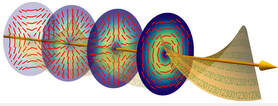Novel polarization forms promise to radically increase data speeds
April 26, 2015
As the world’s exponentially growing demand for digital data slows down the Internet and cell phone communication, City College of New York researchers may have just figured out a dramatic new way to increase transmission speed.
“Conventional methods of data transmission [that] use light … are being exhausted by data-hungry technologies, such as smart phones and cloud computing,” said Giovanni Milione, a PhD student under City College Distinguished Professor of Science and Engineering Robert Alfano, who led the pioneering experiment conducted at the University of Southern California with collaborators from Corning Incorporated, Scotland, Italy and Canada.
“So we came up with an unconventional method.”
Unusual polarization shapes
Using special devices called “q-plates,” the researchers manipulated a laser beam’s polarization (orientation) into novel shapes, some of which Milione referred to as “radial” and “azimuthal.” “While light’s polarization (linear and circular) is used for many modern technologies, such as 3D television, its shape is often left untouched,” he said.
The researchers showed that each shape could carry an additional data stream. While the researchers used only four shapes, in principle, the number that can be used is unlimited. “The amount of data that can be transmitted on a single laser beam can be scaled to terabits or even petabits,” said Alfano.
“This technology is potentially compatible with building to building communication (such as in NYC) or even between Google data centers.”
Their research, supported in part by DARPA, the Army Research Office, and Corning Incorporated, appears in an upcoming issue of the journal Optics Letters.
Abstract of 4 × 20 Gbit/s mode division multiplexing over free space using vector modes and a q-plate mode (de)multiplexer
Vector modes are spatial modes that have spatially inhomogeneous states of polarization, such as radial and azimuthal polarization. In this work, the spatially inhomogeneous states of polarization of vector modes are used to increase the transmission data rate of free-space optical communication via mode division multiplexing. A mode (de)multiplexer for vector modes based on a liquid crystal q-plate is introduced. As a proof of principle, four vector modes each carrying a 20-Gbit/s quadrature phase shift keying signal (aggregate 80 Gbit/s) on a single wavelength channel (λ∼1550 nm) were transmitted ∼1 m over the lab table with <−16.4 dB mode crosstalk. Bit error rates for all vector modes were measured at the 7% forward error correction threshold with power penalties <3.41 dB.
